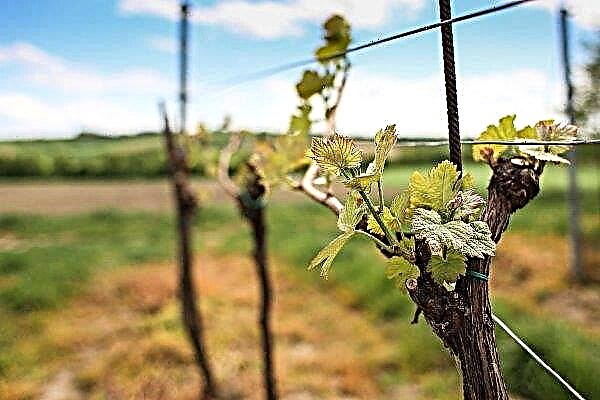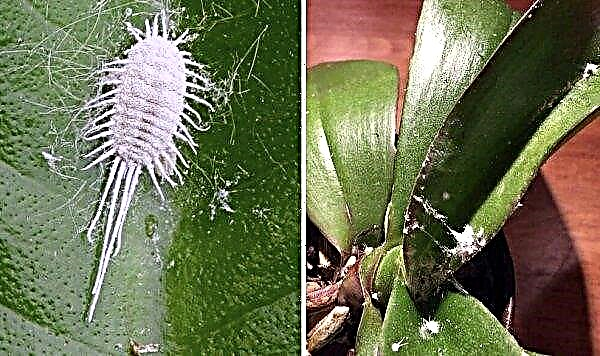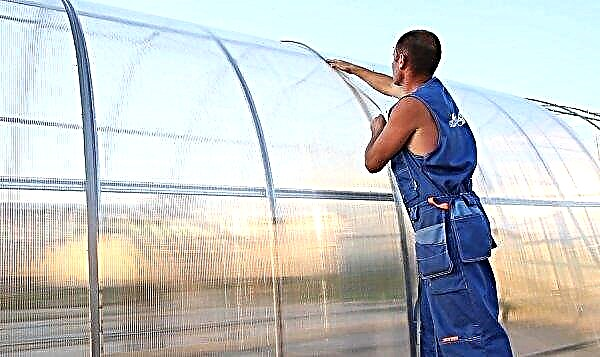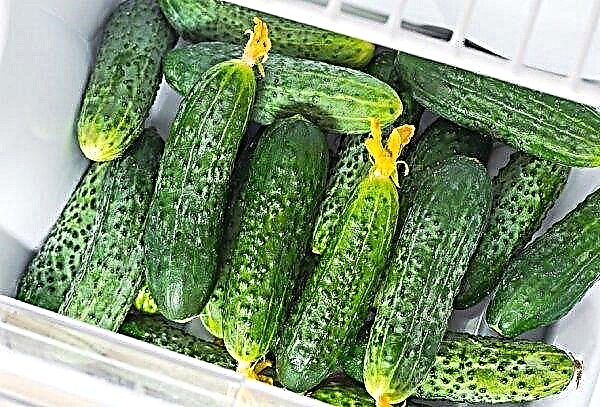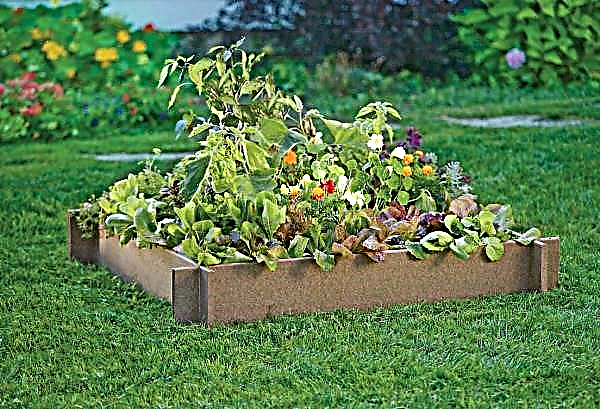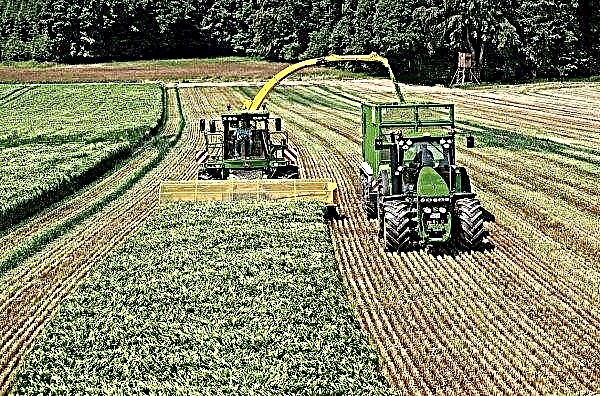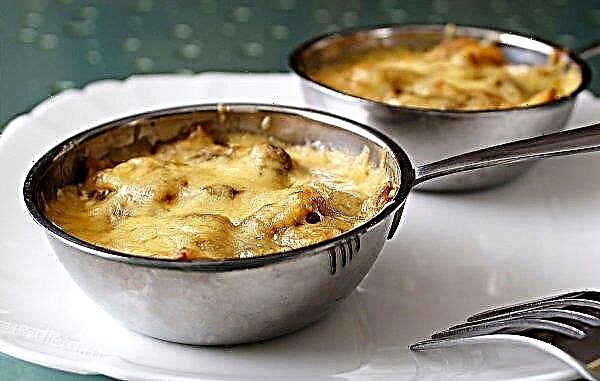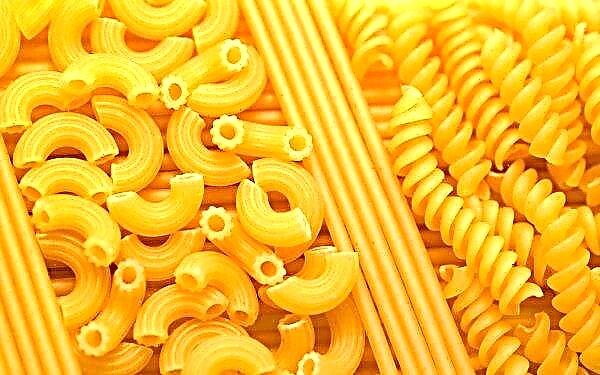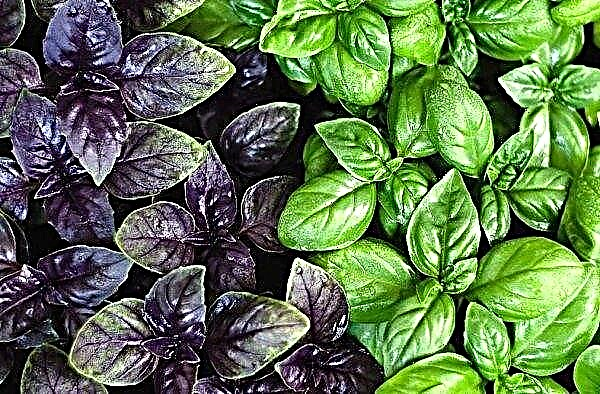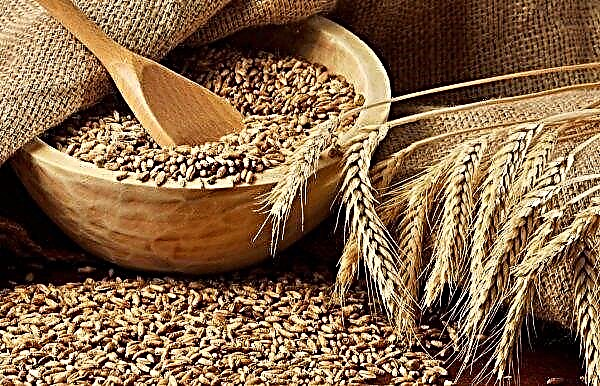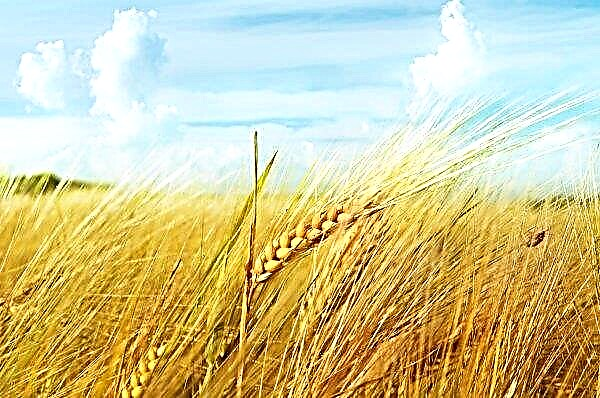Column-shaped apple trees provide an excellent opportunity to grow fruits in confined spaces. Ostankino apple tree became one of the first such varieties. Read about Ostankino's features and growing technology in this review.
Description of the colony-shaped apple tree of the Ostankino variety
Colon-shaped apple trees are characterized by compactness, a straight columnar shape, a height of up to 2 m and a yield of about 10–16 kg per tree. This makes them suitable for growing in small areas, for container growing on balconies and patios.
Given the high decorativeness of such trees, they are also used to create hedges and zoning the site. Each year, these apple trees produce a wonderful harvest. It may vary in volume, but the fact that you will not be left without apples is absolutely accurate. Characteristic varieties Ostankino:
Characteristic varieties Ostankino:
- basic: self-fertile, not requiring pollinators, autumn, fruitful, resistant to disease;
- growth rate: large;
- tree: resistant to wind; early;
- tree height: 2 m;
- crown: compact, elongated, with a diameter of not more than 1 m;
- shoots: only the central stalk is available, on which the gloves and the spear are placed on which fruiting occurs.
Ostankino apple tree obtained by crossing varieties Vazhak and Abundant. This event happened back in 1974 under the direction of breeder V. Kichina from the Institute of Horticulture.
In the 80s, the variety was included in the State Register. The synonymous name for the columnar apple trees is urban (apple trees). They not only take up little space, but are unpretentious to the soil, as urban soils are not fertile.
Did you know? Colon-shaped apple trees obtained at random. First of them — it is a mutated Macintosh branch grafted onto a stock. She got a separate name. — Vazhak proved to be capable of further selective use.
Fruit Characteristics
Apples grown on columnar trees are of normal size. They are simply smaller than on a full-sized tree. They are also characterized by excellent palatability.
Fruit Characteristic:
- apples: round, weighing up to 130-150 g, can reach 200 g;
- skin tone: in technical maturity - green, in ripened form - red, due to intensive coverage of the fetus with a blush, on the non-sunny side the fruit may be slightly greenish;
- peel: thin;
- pulp texture: medium density, juicy, delicate, white;
- taste: dessert, sweet prevails, but there is a slight acidity;
- tasting characteristic: high;
- productivity: 10-16 kg are harvested annually from one apple tree;
- the fruit is excellent, they can be stored until February.

Pros and cons of the variety
- The advantages of the Ostankino apple-tree variety are:
- compactness - the tree occupies no more than 1–1.5 m² of land;
- excellent decorative properties;
- early maturity - fruiting begins at 2 year;
- convenience in leaving;
- high winter hardiness - the apple tree grows even in Siberia;
- large fruits, the average weight of apples is 130–150 g;
- high decorative properties of both tree and fruit;
- stable yield;
- disease resistance;
- good survival rate.
- Disadvantages:
- useful life - no more than 14 years.
Did you know? If apple trees of the Ostankino variety are planted on an area of 1 hectare, then you get 20 thousand trees, which will give 800 tons of fruit. So their productivity exceeds the same parameter for the site with full-sized trees.
Optimal conditions for growing
For the trees to grow large, healthy and fruitful, they need a little more care than just digging a hole and planting them, especially in an urban environment. Therefore, for growing, you will need a sunny area and making changes to the soil structure.
Dense soils are diluted with sand for ease, while sandy soils are supplemented with clay. If there are stones or debris on the site, they should be removed during planting. To improve the growth conditions, fertilizers are introduced into the planting pit.
Characterization of growing conditions:
- sun exposure: full sunshine all day;
- soil type: garden loam, modified clay, mixtures with good fertility mixed with soil;
- soil moisture: moist, well-drained;
- pH level: 5.5–7.5.
Pollinators
The variety is completely self-fertile. He does not need pollinator trees. But if you think that there are not enough bees near your apple tree, sprinkle the trunk with sweet water, its smell will attract more insects. Harvest ripens in mid-September.

Productivity
The yield of one tree is about 10-16 kg of fruit. The change in their number depends on weather conditions and the age of the apple tree. Starting to bear fruit in the second year after planting, the tree continues to develop and after 3 years it enters maximum fruiting.
Planting and caring for a columnar apple tree
Growing columnar apple trees is quite simple. They can grow in winter hardiness zones from 4 to 8 with winter temperatures from –12 ° С to –35 ° С. In practice, this means that the apple tree can tolerate everything except a hot climate. Indeed, to start the next growing season, she needs several months of winter.
Plant trees at a distance of no more than 30 m from each other. The minimum distance between trees is 0.5–0.6 m.  They can be grown not only in soil, but also in containers. It should be watered often, 2-3 times a week. The soil should be neither moist nor dry. Fertilizers such trees also need to be given often. You may need to thin out the ovaries in the first years of growth so that the branches can support the weight of apples.
They can be grown not only in soil, but also in containers. It should be watered often, 2-3 times a week. The soil should be neither moist nor dry. Fertilizers such trees also need to be given often. You may need to thin out the ovaries in the first years of growth so that the branches can support the weight of apples.
Landing rules
If you are ready for planting, the first thing to do is soak the roots for 2–4 hours before planting. They must be wet during planting.
Did you know? Modern apple trees come from wild ancestors, which still grow in Kazakhstan. This tree is called the Sievers apple tree.
The purchased seedling should have the following features:
- age: 1 year;
- trunk: straight;
- height: 60–70 cm;
- side branches: absent;
- damage, defects and deformations: none;
- leaves: absent;
- bark: fresh, bright;
- roots: developed, white, fibrous on a section;
- root neck: clean, healthy.

If this is a two-year-old seedling, then it should have a small stambik and 4-5 branching branches from the central trunk. The central root should not be broken. If it is damaged, refuse to purchase. Such a seedling does not take root.
If a seedling is bought in a nursery, then it comes with a tag on which the grade and age of the plant is indicated. You can also request other information about the variety: fruiting period, resistance to diseases and pests, regionalization.
Important! Apple trees can not be planted in places where the same trees grew. Over the years, many phytopathogens and pests have accumulated in the soil that can attack the seedling.
Landing technology:
- A pit for landing is prepared in the fall, but the landing itself is carried out in the spring. The standard pit has a depth and diameter of 0.5 m. The distance between adjacent trees is about 3-4 m.
- In a dug hole, drainage is necessarily laid on the bottom. It can be crushed stone, pebbles or other material. Its task is to prevent prolonged contact of the root system with moisture. Drainage depth - 20 cm.
- The soil is mixed with a bucket of humus; superphosphate and potash fertilizers of 90 g are added.
- Lay the prepared mixture for drainage.
- Straighten the roots and set the tree in the center of the pit.
- They fill up the hole, starting from the sides and moving towards the center.
- If possible, the soil is compacted.
- Introduce 1-2 buckets of water to moisten the soil.
 It remains to make sure that the connection point of the scion and stock is above ground level.
It remains to make sure that the connection point of the scion and stock is above ground level.
Watering and feeding
The yield of an apple tree depends on how well it was watered. Ostankino, like other columnar varieties, needs to be watered 2-3 times a week. Enough 2-3 buckets of water for each tree. If moisture quickly leaves the soil due to its lightness or heat, then you can cover the root zone with mulch - sawdust, straw, and other material. This will keep the soil moist and fairly loose.
Excess water is just as harmful as lack. If it rains and moisture in excess, then watering is not needed. Just make sure that the soil is neither swampy nor overdried. In wetlands, the roots lose their ability to absorb nutrients, diseases develop and the tree can die.

During the growing season, 3 top dressings for a columnar apple tree are carried out. The first is before the buds open, the second at the time of flowering and the third in June, when the fruits begin to ripen. The rate of mineral application is 50-60 g / 1 tree.
You will need a balanced fertilizer with an equal ratio of nitrogen, phosphorus and potassium: 12-12-12 or 14-14-14. Fertilizers can be applied in the form of granules into the soil or dissolved and applied as a solution. Gardeners also make 1 bucket of humus before the start of the growing season once a year.
Pruning
The tree is formed in 1 trunk and has no lateral branches. Its standard height of 2 m also does not require shortening. Therefore, we can safely say that pruning the apple tree is not needed. The exception is genetic failure, as a result of which the apple tree can begin to grow lateral shoots. In this case, they are removed. But this happens in exceptional situations.
Whitewash
Whitewashing is a way to protect the trunk from temperature extremes in winter. The bright sun heats it. Wood is a poor conductor of heat. Therefore, the trunk does not have time to cool before a frosty night, which leads to cracking.
Important! More modern European whitewashing method — latex water-soluble paint. It is mixed with water in a ratio of 1: 4 and whitened the trunk. If apple trees perform a decorative function, then you can choose for this any light shade of paint.
The danger of cracks for a small apple tree is that it can slow down its development and become a gateway for penetration of pests and plant pathogens. Trees are whitened 2-3 times a year. The main whitewash is autumn. For its use, lime. Apply lime mortar along the trunk to a height of 40-50 cm.

Winter preparations
If the crop has already been harvested, then the garden begins to prepare for winter. Trees must be protected from rodents, pests, infections and temperature extremes.
Key actions:
- whitewash trunks;
- removal of fallen leaves, weeds and fruit residues from the garden;
- pruning of dried branches;
- digging the soil;
- placement in the near-barrel zone of a layer of mulching material.
Diseases and Pests
The main pest of any apple tree is the codling moth. A butterfly codling moth lays eggs in an ovary. Hatched larvae will live in growing fruits. One caterpillar is able to damage not only the apple in which it is located, but also crawl into another.

Over the summer, up to 3 generations of this pest appear, each of which will lay eggs. Spraying from the codling moth is carried out as soon as the apple tree fades. It can be Mitak (20 g), Biorin (10 ml), Intavir (1 tablet). Dilute any substance in 10 l of water and spray on a calm day. They will need about 3 pieces with an interval between them of 40 days.
Since trees cannot be completely protected from contact with insects, farmers also apply:
- attracting birds to the garden by hanging feeders;
- hanging traps with pheromones - the norm is 1 trap per 100 apples.
Did you know? Other insect predators are often attracted to insect control. So 1 ladybug can destroy up to 5000 aphids in his life. To attract ladybugs into the garden, plant fragrant plants, such as mustard, between the rows.
If pests are found, the tree is sprayed with one of the insecticides for complex use. This allows not only to destroy the detected insects, but also to create a barrier to attacks in the near future. Colon-shaped apple trees are resistant to fungal diseases. Therefore, if you water them correctly and water does not stagnate at the roots, then there will be no problems with diseases.
Harvesting and storage
Ostankino will enter fruiting in the second year after planting. Some gardeners remove the ovary of the second year in order to allow the tree to gain strength for further growth and development. In the next few years, productivity will increase. But it will not necessarily remain stable. Therefore, you can collect as much as 10 kg of fruit from one tree, and 2 times more.

Apples ripen in September. The main criterion for ripeness is a color change. Apples from the stage of technical maturity are green. As they mature, they turn red. The intensity of red color depends on the amount of sun that is received by specific fruits.
Harvesting is carried out in dry sunny weather. The collected apples are sorted. Deformed, damaged, struck put aside for processing or use in the near future. Only undamaged fruits are taken for storage.
They are placed in boxes or boxes. Storage of apples is possible for 4-5 months. They have excellent keeping quality. Boxes with fruits are installed in a room with an air temperature of about 0 ° C and a humidity of 70–80%.
Tips from experienced gardeners
Gardeners are advised to choose varieties, taking into account your frost resistance zone. Colon-shaped apple trees are not too strong to maintain the possibility of fruiting if in the winter their fruit buds die from frost.
It is also important to consider that:
- Foliage is needed for photosynthesis. Do not experiment with removing it. After all, to get 1 apple, the tree uses the energy of 50 leaves.
- For southern regions with hot summers and warm winters, you need to consider that a tree needs 1200 hours of frost in order for it to enter a new vegetation cycle. Therefore, in regions with positive temperatures in winter, the apple tree will be very uncomfortable.
- The size of the tree can be controlled. Just pinch the central shoot. Use only sterile instruments during operation.
- Some varieties of columnar apple trees need a pollinator tree. Check this question with the seller if you will buy any other variety except Ostankino.
- Small trees can also be grown in containers. For such an apple tree, it should be at least 50 cm in depth and in diameter.
- In order to decorate the territory, columnar trees are often planted surrounded by ground cover plants. This eliminates the need for loosening the soil and removing weeds.
Video: Ostankino column-shaped apple tree
Caring for colon-shaped apple trees is no more difficult than for ordinary ones. They can be recommended for growing to anyone who has a small plot for growing fruit trees. By following the simple guidelines for caring for them, you will provide yourself with fresh, fragrant apples every year.

